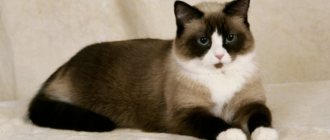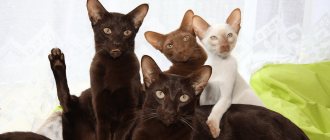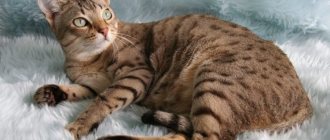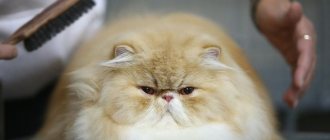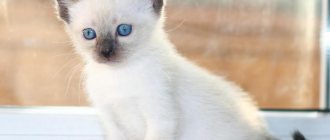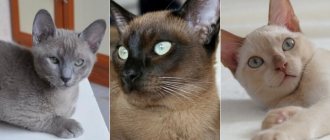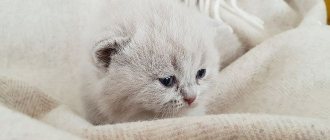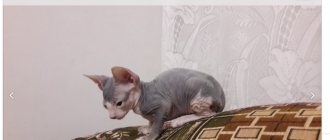There is an unspoken competition between cat lovers to see whose animal is the most unusual. Owners of cat breeds laperm (La Perm) are close to victory. Their favorites are certainly among the top ten amazing tailed creatures. Everyone who has met a laperm cat believes that it is enough to take her in your arms and she will win a person’s heart.
Fingers running through the cat's soft fur feel the warmth of her body and the tenderness of her character. The unusual fur gave the animal a second name: alpaca cat. The third name was obtained from the place of origin of the breed: Dalles La Perm.
History of origin
This is a fairly young breed that arose unintentionally and was noticed completely unexpectedly. The first representative was born by accident. In 1982, in the family of farmers Richard and Linda Coel (Dallas, Oregon), an ordinary tabby cat gave birth to six kittens. But one of them was not like the others - he was born bald, wrinkled, and the owners thought that the baby was unlikely to survive, since he seemed weaker than everyone else. However, the cat grew up very strong and healthy.
The mother of the unusual kitten, a simple outbred hunter cat named Speedy, did not have any special features.
All the kittens in the litter looked like her, but this hairless baby became the owner of large, wide-set ears, curled whiskers (whiskers) and a thin, long body with folded skin.
At the age of about two months, the cat began to grow hair. It was soft and pleasant to the touch. Over time, the hairs began to curl.
The kitten's fur naturally curled on its own, so the owner named her pet Curly, which means “Curly.” Initially, the owners did not pay much attention to the unusual pet, however, when the cat matured and began to bring her own kittens, they noticed that many of the babies also looked like their curly-haired mother.
The owners became interested in this feature and decided to consult with professional felinologists. The cat was shown to specialists and what a surprise it was when it turned out that this genetic mutation turned out to be very rare in the world of cats and had never been found anywhere before! The gene responsible for the special structure of cat hair turned out to be dominant and was well passed on to subsequent generations.
The name of the LaPerm breed comes from the French and English words “la” and “perm,” which literally means “permanent perm.”
The owners decided not to neglect their pet’s peculiarity any longer and began seriously breeding cats with curly hair. They studied a lot of information and often consulted with professional geneticists, felinologists and veterinarians. General interest in these beautiful pets quickly grew, and already in 1992 Linda Coel exhibited several of these cats at an official exhibition in Portland.
Unprecedented success and universal attention awaited the unusual participants, so Linda continued her painstaking work to create the breed and founded the first Laperm kennel. She wrote the first breed standard in 1997. Since then, work has begun to strengthen the qualities of the breed. This involved Siamese and Men cats.
The process of official recognition turned out to be very long - only in 2002 Lapermov was recognized by TICA, in 2008 and 2011 some other large organizations were recognized and after that they established a single international standard. Now the breed continues to develop, adjustments are being made and work is underway to preserve the phenotype, but the characteristic features of the Laperms have been successfully strengthened.
The best shampoos for cats, both regular and specialized medicinal, rating of popular ones
Breeding
The dominant curly gene allows you to get curly offspring even when crossing a La Perma with an ordinary cat. However, it is necessary to remember that such kittens will not be considered purebred.
To obtain offspring that have the rights to pedigree, breeding and an exhibition career, you need to find a worthy mate for your La Perma. The easiest way to do this is at the club - there they will share the necessary information and contacts with the owner.
La Perm is both good-looking and sweet in character, but she still remains, probably, the rarest cat in our area. There are about thirty of them in Moscow; There will be as many more throughout Russia. In a word, it is almost impossible to see La-Perm at an exhibition; you can spend your whole life at exhibitions and never meet La-Perm.
https://vk.com/topic-29887936_25084470
Breeder Polina Ostrizhko
A litter usually produces from one to eight kittens. A cat can give birth two to three times a year. However, to maintain her health, it is better to breed about once a year.
La Perma kittens are born both hairless and covered in fur. The latter soon go bald, becoming like their naked brothers. But at the age of two weeks, both begin to become covered with hair.
La Perms can be born with or without fur.
The best food for babies is mother's milk. If for some reason breastfeeding becomes impossible, kittens need to purchase a special formula. Cow's milk is not suitable for feeding kittens . After eating, the baby needs to lightly massage the tummy with a piece of cloth dipped in milk - this improves digestion.
Shredded boiled beef, minced chicken and egg yolk are used as the first complementary food for small La Perms.
At the age of four months, the kittens will be sufficiently strong, will receive their first vaccinations, and will also learn the necessary behavioral skills from their mother. Now they are ready to move to a new home.
Kittens require mother's care until they are three to four months old.
Characteristics and features
These cats are the embodiment of an unusual combination of playfulness and tenderness, modesty and perseverance. Laperms are very loving, but they do not single out one favorite in their group. They treat all family members equally, including other pets, be they dogs or cats. However, with rodents, their hunting instinct may be triggered.
The characteristic behavior of the LaPerma is the need for physical contact. These pets love to be stroked and scratched, and if they feel a lack of such attention, they will certainly begin to demand affection.
Cats constantly try to snuggle on their owner’s lap; they like to climb on shoulders and touch the face. At the same time, they are very delicate and will not forcefully approach their owner when this is inappropriate.
Laperms are hospitable and will be the first to meet new people with curiosity. It is noteworthy that they are caring cats and get along well with children. They enjoy entertaining kids with various tricks during games and receiving attention and admiration from their young owners.
Another valuable feature of Laperms is their high level of intelligence. These pets are highly trainable; it is absolutely not difficult to accustom a small kitten to the litter box and routines in the house; adult pets are easy to teach new tricks.
Laperms learn their name well and readily respond to their owner’s call.
These cats are inquisitive and always ready to discover. At every opportunity, they try to study their surroundings, come up with fun and proudly demonstrate their achievements to their owners. Tireless lovers of play, Laperms will happily spend the entire evening nestling on their beloved owner’s chest or feet.
Representatives of the breed are sociable and love to “talk”, like their Siamese ancestors, however, LaPerms have a quiet voice and thus do not cause inconvenience. These cats have well-developed facial expressions, expressive eyes, and therefore they can easily demonstrate their feelings.
These cats are optimistic by nature and have a certain dreaminess. They sense the owner’s mood well and reciprocate. They quickly get used to strangers, do not feel constrained when meeting them and behave openly, but remain faithful only to their beloved family members.
Characteristics of laperm cats
These cute pets are distinguished by their special affection for humans; they not only need your love and attention, but also give all their devotion and affection in full.
Perhaps the favorite pastime of laperms is to lie next to you, purr and gently touch a person with their paw, this is how they show how much they love you. Laperm kittens are very sociable, but their voice is quiet and pleasant; occasionally the cat can express itself in louder tones, but this only happens in cases of hunger and lack of attention. Such an animal should not be kept in a house where there is often no one; this curly-haired cat can only tolerate short-term loneliness, but even in this case it is better to provide it with some kind of entertainment. Lapermas are very active and energetic; if you invite them to play, their unbridled agility and energy will undoubtedly surprise you. This is probably why small children become these purrs' best friends. Cats can spend hours chasing a string or a ball. They are lenient and patient with children. If another cat or even a huge dog lives in your house, there is no reason to worry. The curly-haired LaPerm cat will get along with anyone, with the exception of those pets that can be hunted and, once caught, eaten. So, if this hunter has to share a roof with a parrot or a hamster, then he needs to keep an eye on them. It is best that small animals come into contact with the cat as little as possible, otherwise his persistence and resourcefulness can lead to very disastrous results.
Laperm cats are very smart and curious, so if you come home and cannot find your tailed friend, look on the top shelf of the closet or on the refrigerator, you will definitely find him there. Therefore, owners of such “households” are advised to put all valuable and especially breakable items behind tightly closed doors.
It is also not good to remove the wires of electrical appliances from sight; if this is not possible, then you should sprinkle them with lemon juice, otherwise these dangerous things will become your pet’s favorite toy and it is not a fact that they will not cause some kind of trouble.
Description of appearance
Laperms are difficult to confuse with cats of other breeds. For example, the British Chinchilla, Nibelung or Ragamuffin also have long hair, but its structure is significantly different. The Laperma's coat is curly or wavy, soft and pleasant to the touch, which makes their appearance stylish and somewhat romantic. There are short-haired and long-haired individuals. They have a proportional build, these cats are flexible and agile. Representatives of the breed are medium-sized pets with refined features. They have a small head with large ears, expressive eyes and understandable facial expressions. You can easily read your pet's emotions.
LaPerms have a peculiar posture - the lower back is located slightly above the shoulder line, since these cats have well-developed hind legs. It may appear that your pet is walking on tiptoes. The limbs are quite thin, yet flexible and strong. The graceful tail emphasizes the smoothness of movements.
Interestingly, kittens are born bald or with straight hair. Only by 4–6 months does the fur become similar to that of adult cats, so it is impossible to predict how a small kitten will grow up. On the stomach and head the hair curls the most, and on the tail it puffs up the most. The colors can be varied, both monochromatic, bi- and tricolor, but more often monochromatic.
Education and physical activity
Laperms are highly intelligent cats that are highly trainable. They quickly get used to a certain routine and understand how to use the tray and scratching post. Curly-haired cats, like dogs, come running when called by their owner and can perform simple tricks.
Agile and resourceful, Laperms have an active temperament and easily jump onto high cabinets and shelves. To realize their hunting instincts, it is advisable for cats of this breed to buy interactive toys and set up a play corner.
Breed standard
According to WCF and FCA, representatives of the LaPerm breed must meet the following canons:
Head
- wedge-shaped with neat rounded features;
- the ears are large, set wide, set high, deep;
- Long-haired cats may have tufts at the tips of their ears;
- forehead neat, flat;
- the bridge of the nose is quite thin, the nose is small, the color matches the color of the coat;
- the eyes are almond-shaped, large, expressive, any color is acceptable, the gaze is open, attentive, lively;
- lips are neat, whisker pads are rounded and dense;
- the chin is wide and strong; the profile is straight.
Neck
Thin, graceful, but strong, long, proportional to the body.
Torso
- medium build, delicate constitution, somewhat refined bone structure;
- the line of the back is slightly raised towards the tail;
- the main thing is that all items must be proportional.
Forelegs
- neat, sophisticated, may be slightly shorter than the rear ones;
- The paws are gathered in a bun, rounded, the toes are neat and small.
Hind limbs
- quite muscular, but at the same time graceful, due to the fact that the length is longer than the front ones, it seems that the cat is constantly rising, walking on outstretched paws;
- The fingers, as on the front ones, are small and neat, tightly tucked.
Tail
proportional to the body, gradually tapering towards the tip, of medium length.
Wool
- she is given special attention;
- in long-haired cats it can be frizzy to varying degrees - from wavy to curly;
- looks somewhat carelessly disheveled;
- light, soft and fluffy, also loose, soft;
- it is easy to reach the skin through it;
- there may be a curly collar, tassels on the ears;
- short-haired individuals have slightly coarser hair, but the main characteristics are similar;
- on the tail the hair curls especially intensely and sticks out; on the back it can part and hang down on the sides of the spine;
- vybrissae twisted, long, flexible.
Color
Many colors are allowed - cinnamon, white, black, red, blue, chocolate, bi- and tricolors, etc.
Dimensions
- cats are noticeably larger than cats;
- the weight of males is 4 - 5 kg, females - 3 - 4 kg.
And here you will find the schedule of WCF cat shows for 2020.
Features of care
To comb out curly hair, a comb with rounded teeth is useful. Brush your cat daily to remove loose hairs and avoid tangles.
Kittens up to one year old may suddenly lose all of their fur. This is normal - then the fur coat grows back and becomes better.
Because of their curls, this breed is more often visited by skin parasites - fleas or ticks. In a thick fur coat they are more difficult to notice, so inspect the cat very carefully. Laperms also need to be bathed monthly to maintain a healthy coat.
The breed does not have any typical diseases, but do not forget to follow the vaccination schedule and regularly take your cat to the veterinarian for preventive examinations.
Health and life expectancy
In general, the breed is healthy, there are no genetically transmitted diseases. This is due to the spontaneous occurrence of Laperm and the use of strong phenotypes of cats to strengthen the breed characteristics. However, parasitic infestations (fleas, ticks, helminths, etc.) may occur. Allergic reactions rarely occur. Lapermas can suffer from infectious viral and bacterial diseases, as well as diseases caused by single-celled protozoa.
With proper care, pets live up to about 15 years. Some pets live longer.
Death can be caused by congenital malformations (extremely rare), serious viral diseases, parasitic infestations and associated diseases, and dangerous injuries. Improper maintenance, poor and unbalanced nutrition can also shorten life expectancy.
Cats need to be given enough attention; in adolescence, good socialization is required, otherwise pets may suffer psychologically, which is expressed in depression, which is not typical for this breed.
Feeding the cat
Laperma can be given both industrial and natural food. In the first case, the curly-haired cat is fed premium or super-premium class dry food, which contains all the necessary microelements and does not contain any questionable additives.
These requirements are best met by:
- Royal Canin;
- Monge;
- Bosch;
- Brit Care.
When feeding natural products, the Laperm diet is thought out so that it is based on lean, fresh meat. Also included in the menu for curly cats:
- boiled vegetables;
- porridge with water;
- eggs;
- dairy products;
- lean sea fish;
- offal.
Cats of this breed should not be fed bones, sweets, baked goods, sausages or whole milk. Laperms are also forbidden to give river fish, smoked meats, pickles and any food from the master’s table.
Varieties, their features and differences
LaPerm is a young, established breed of cat that has several varieties. There are long-haired and short-haired Laperms. Both options are approved by world felinological associations, are equally relevant to the breed and are acceptable.
Longhair
Long-haired representatives of the breed have softer and lighter hair, and the coat looks more disheveled. A parting may form on the back along the spine. There are often tassels on the ears, but their presence is not necessary. Long-haired LaPerms with a fluffy, curly collar are also common. The fur all over the body can lie in beautiful waves or curl down to small curls. The fur is especially lush on the tail.
Shorthair
Short-haired pets have a stiffer and denser coat. The hair curls more intensely, and representatives of this type of breed are somewhat similar to Rex. In general, the hair is elastic and loosely adheres to the body. There are no tufts on the ears; the hair on the tail is also more luxuriant and curly, bristling as much as possible. Unlike their long-haired relatives, guard hairs grow mainly on the belly and back.
Long-haired and short-haired LaPermas do not differ in body type. Their appearance is formed mainly by hair. Both representatives of the breed are sophisticated cats, they have the same posture and appearance.
Kinds
There are two types of lapermas:
- shorthair,
- long-haired.
Short-haired animals have wavy hair mainly located on the back and belly. The length of the guard hair is short. The texture of the wool is light, airy, and soft. Does not adhere to the body, gives the impression of dishevelment. On the tail, the guard hairs stand up, like the hairs on a bottle brush.
In long-haired laperms, the entire body is covered with guard hairs of medium to long length with curls. The guard hair does not adhere to the body, it bristles. The texture of the coat is soft in the ventral part, elastic on the back and other parts of the body. Due to the long hair, the cat's disheveled appearance looks more impressive than that of short-haired laperms.
Beautiful photo
Sexual differences between male and female cats
Representatives of this breed have fairly developed sexual dimorphism (differences between females and males). Males are noticeably larger than cats, the muzzle has a more masculine expression - the chin is more powerful, the nose is somewhat wider, the forehead is also wider and more convex, the cheekbones are stronger.
The difference in weight can be 0.5 - 2 kg, despite the fact that the breed is not large. Cats are more refined in general, noticeably more feminine, their faces are neater, their paws are smaller.
The behavior is also different. Although Laperms are very friendly and sociable, males are more courageous and more often show jealousy and can defend their territory. Both male and female cats love to hunt. Representatives of both sexes are equally playful and inquisitive.
It is easier for a female to accustom herself to new pets in the house, she gets used to guests faster, but in general this is purely individual, and a male can also easily accept a second cat or dog, a child or a large group of guests and become their new cheerful friend.
Laperm character
| Activity |
| Playfulness |
| Sociability |
| Affectionateness |
| Friendliness |
| Intelligence |
Laperm is obliged to hug every person he meets! These cats adore people and try to sit on someone’s lap and purr. And the laperms purr very loudly.
If you pay even a little attention to the laper, the cat will consider you his best friend. Laperms love everyone: children, cats and even dogs.
Curly-haired cats love nothing more than to sit in public. On your knees, on your stomach, back, shoulders - it doesn’t matter! The main thing is to warm up your beloved owner. Laperms have a hard time being alone, so the breed is not suitable for workaholics. These cats feel best in a large and friendly family.
Feeding
It is not recommended to take a one-month-old kitten away from its mother, but sometimes there is simply no other choice. In this case, you will have to feed the kitten at least six times a day and follow a lot of other rules. Read about this in a separate article.
Further, all general rules for feeding kittens according to age apply to the kitten.
Laperms are unpretentious eaters; they will easily eat both homemade food and branded food. However, to maintain health, it is necessary to provide only high-quality products. If the owner prefers natural products, you need to carefully balance the diet. Periodically include fortified mineral supplements and take breaks between courses. Main foodstuffs:
- meat (beef, rabbit, turkey - always boiled);
- cereals (rice, buckwheat, a little less often - oatmeal);
- fermented milk products (low-fat cottage cheese, kefir, hard cheese);
- sea fish (in moderation, always deboned);
- vegetables (carrots, zucchini, pumpkin);
When choosing vitamins, preference should be given to complex ones or for the skin and coat; you also need to take into account the age and physical condition of the pet.
It is prohibited to add spices to food or feed fried or smoked foods.
If it is more convenient to use ready-made food, it is better to buy products of at least premium class. You can feed dry, canned food, or a combination. However, you cannot combine products from different manufacturers, since the composition of each is individually balanced and these proportions can be disrupted, which is harmful to the pet’s body. Also, you should not mix natural and branded products.
For the convenience of feeding your pet, we recommend purchasing an automatic cat feeder, which has many useful functions. Read more about it here.
Be sure to purchase an automatic waterer for cats. In this case, your pet will receive clean, filtered water enriched with oxygen.
Nutrition
The nutrition of laperm cats is defined by three words: a cat is a predator. Therefore, when preparing a cat's dinner, the main attention should be paid to meat, of any origin, but lean. Organ meats are an excellent source of animal protein and vitamins. Ingredients of animal origin make up 50-70% of the total volume of a cat's dinner.
Some vegetables, boiled cereals and fermented milk products are added to the main (meat) components. Vitamins and supplements containing essential microelements are desirable. Don't forget about a bowl of clean water.
Not everyone can afford to spend time preparing complex, balanced meals. Purchasing ready-made food has become the most common way to organize cat nutrition.
Advantages and disadvantages
LaPerm cats are wonderful pets, easy to care for and pleasant to talk to, but they are not suitable for everyone who wants to have such a beautiful pet. Their character is contradictory and interesting. These pets have a number of advantages:
- cats are perky and friendly, get along well with children;
- interesting in communication;
- have a quiet voice, so they do not irritate with noisy screams;
- Laperm's appearance is a characteristic calling card;
- combine playfulness and tenderness;
- easy to maintain;
- They learn well, perceive certain commands, and quickly understand the order of the house;
- loyal to the owner and friendly with guests;
- hypoallergenic.
Representatives of the LaPerm breed also have some disadvantages:
- require constant attention, so they are not suitable for constantly busy people;
- the coat needs special care to maintain its appearance;
- need physical contact, so they can persistently climb into your arms, jump on your shoulder, touch your face;
- Laperms with access to the outdoors can regularly bring “gifts” to their owner in the form of captured mice, birds or insects;
- It is difficult to purchase a kitten, as this is a very rare and expensive breed.
Laperm is perfect for a family with children; it is not a problem if there are other pets in the house. These sociable cats will only be happy to spend active time with games and fun. They are non-aggressive, loving and enjoy attention.
If the owner constantly disappears at work and the cat is left to its own devices, Laperm can damage the interior, become sad or become aggressive. These problems are related to the psychology of the breed, so you need to take all aspects into account before getting a LaPerma.
Care and maintenance
Curly-haired cats in their recent past had outbred, rural ancestors. The gene mutation that caused curly hair did not affect other body functions. Therefore, the animals turned out to be very healthy. Lapermas do not require special supervision from a veterinarian; it is enough to organize the fight against helminths and carry out traditional vaccinations.
For long-haired creatures, the main object of care is fur. It is combed daily, although the coat is not particularly thick and rarely becomes tangled. Ears and eyes are inspected and cleaned every 3 days. Animals going to an exhibition are given a more thorough check, combing and even a complete wash with special shampoos.
The care for animals that have access to the outdoors and those that are completely indoors differs somewhat. Having been in nature, a cat can bring sources of disease and other troubles on its fur and paws.
Purchase and price in rubles
This breed is young and therefore quite rare, but has received universal recognition and fame. In Russia, it is very difficult to find a Laperm kitten; there are no nurseries specializing specifically in these cats. However, private breeders – connoisseurs of the breed – can become an alternative. In the United States, the breed is more common, but is also considered rare.
Becoming the owner of LaPerm is difficult, but possible. The price of a kitten, depending on the breeder and the qualities of the baby itself, ranges from 300 to 5,000 dollars, which is equivalent to approximately 20,000 to 350,000 rubles.
Temperament and behavior
La Permas not only have a beautiful appearance, but also an amazing temperament. They value human contact; they are gentle and affectionate animals - true companions. La Permas cannot stand being alone, so you should not leave them alone in the apartment for several days. A bored pet, demanding attention, can change its usually quiet voice to a loud and ringing meow.
A cat with the character of a dog, that's for sure. And I’m not talking about hunting qualities at all:) it’s something infinitely affectionate, tame to the point of annoyingness. Smart, very stubborn, small, thin, but strong. He's banging on the door like a mover.
Lala Ra
https://vk.com/topic-29887936_25084653
Otherwise, they are unpretentious and get along well with other pets, including dogs and cats. They treat children delicately, are not prone to fights and prefer to hide from kids pestering them. The attitude of La Perms towards strangers is developed depending on their upbringing. If a kitten has been accustomed since childhood to the fact that there are often guests in the house, he will not mind communicating with strangers, especially when they show attention to the animal. Introverted owners raise pets that are wary and reserved towards those who are not family members.
La Permas get along well with other pets
La Permas are considered juveniles until they reach two years of age. However, even then they remain active, curious and playful. They especially like to climb onto high places - carpets, cabinets and even the owner's shoulders. La Permas generally love to move and participate in games, so in order to avoid torn curtains and wallpaper, it is better to give them due attention. The accumulated energy of a cat can turn an apartment upside down.
These cats love to climb on high furniture.
These animals will be equally at home both in a city apartment and in a country house. But, as if remembering their farming origins, they do not lose their ability to hunt.
Interesting Facts
- Many LaPerm cats are calm about water; they can easily frolic in the rain or even swim in the bathtub.
- This is one of the most talkative breeds. They can compete with Orientals and Siamese cats, however, unlike those, LaPerms have a quiet, non-irritating voice.
- The fur of these cats has a number of specific properties. Laperms are hypoallergenic, since they do not have an undercoat, and the curling hairs prevent the excessive loss of particles of dead epidermis (the top layer of skin).
- Representatives of this breed are characterized by total shedding, when they completely lose their hair. This phenomenon is reversible and after some time the pets again grow new hair, which curls again as it grows.
- Since LaPermas are extremely intelligent cats, they quickly remember their name and quickly begin to respond to it. Also, if you properly interest your cat, you can teach it to perform some tricks.
- Starting from 2020, they plan to ban crossing LaPerm with other cat breeds in order to consolidate appearance traits, and felinologists will have the right to resort only to intrabreed crossing.
Recommendations for keeping and caring for a laperm cat
- Grooming.
In order for a laperma fur coat to always look luxurious, it needs proper care; it is not complicated, but mandatory. The cat should be brushed approximately once or twice a week with a comb or a soft, wide-toothed massage brush. If you don’t do this, then the animal’s cute curls will turn into abundant tangles that need to be cut off, and this will not make the cat particularly attractive. During periods of shedding, it is better to brush your pet three to four times a week, since due to the lack of undercoat, they do not shed too much. Don’t forget about water treatments; representatives of this type of cat need to be bathed approximately once every one and a half to two months using natural-based shampoos and conditioners. You shouldn’t skimp on detergents, as a poor composition can easily ruin the quality of a Laperm cat’s fur coat. After bathing, it is important that the fur dries on its own; do not use a hair dryer under any circumstances, firstly, animals are terribly afraid of it, and secondly, this is also undesirable for curls. - Ear cleaning
is carried out regularly, at first it is better to carry out this procedure weekly, and then you yourself will be able to determine the optimal frequency, since in some cats a large amount of earwax accumulates in a week, and in some cats there is nothing to remove even in two months, so this It's a purely individual matter. You need to clean your ears using cotton swabs and an auxiliary product; Ottifree drops show good results. A few minutes before the procedure, you need to drop two or three drops of the substance into each ear of the cat, this will be enough for all the impurities to break down a little, after which you need to carefully clean the external auditory canal with light circular movements. It is better to buy cotton swabs with a limiter, so as not to damage your friend’s vulnerable eardrum. - Teeth cleaning
should be done as often as possible, since lapermas have a tendency to deposit tartar, which in advanced cases can lead to tooth loss. You need to brush your teeth with a special, soft toothbrush; if this curly cat is categorically against brushing, you can use a piece of clean, lint-free cloth. You need to wrap it around your index finger, apply a small amount of tooth powder or paste to the cloth and carefully clean the animal’s teeth and, if possible, the soft tissues of the oral cavity. In addition, special food for cleaning teeth should be added to the diet of this exotic with curls; the packaging should have the appropriate o. One of the best foods for cleaning teeth is Royal Canin brand food. - eyes
should be wiped weekly for disinfection purposes; for this you need to prepare two separate cotton pads and some kind of disinfectant. This can be a solution of low concentration boric acid, potassium permanganate, a decoction of herbs (calendula, chamomile) or tea leaves. You can also use special napkins, for example, the Trixie brand. It must be remembered that normally, in the inner corner of a cat’s eye there may be either transparent discharge or brown crusts; if you notice purulent or blood clots, your pet should be shown to a veterinarian. - claws
approximately 2 times every month and a half; this should be done with very sharp tweezers so as not to expose the laper cat to hellish pain when the claw plate is split. You can only cut off 1–2 mm of the transparent tip. And the best alternative to this unpleasant and, more importantly, dangerous procedure is a scratching post. It is recommended to accustom a kitten to this attribute from an early age; usually the baby just needs to move the cord over the scratching surface, and he will already pay attention to it. If not, then you can drop a few drops of valerian and the trick is in the bag. - What to feed?
If you are a supporter of natural food, then you need to prepare food for a Laperm cat with the following products: lean meats (chicken, rabbit, turkey), chicken and quail eggs, cereals, vegetables, dairy products, offal. Occasionally they provide marine fish. With this diet, it is good to feed your pet with additional vitamin and mineral complexes once every six months. As for ready-made food, the best option would be premium or super-premium food, these include food from the brands Bosch SANABELLE, ProNature, 1 Choice, Profine Adult Cat, Cimiao, Royal Canin, Hills, Brit, Advance, Guabi, Happy Cat, Natural Choice and others.


